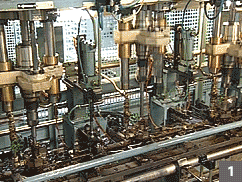 |
 |
 |
| Honing of the connecting rod bores |
 |
   |
|
 |
Connecting rod.
For connecting rods too, STIHL divides between forged and stamped con-rods, depending on specific requirements. The forged con-rods, which have to provide higher performance, are drilled, the faces are ground and finally the bore holes are honed; that means the bore-holes are subjected to extreme tight tolerances.
It is especially important in this process that the distance between the two holes for the stroke and piston pin complies to tight tolerances to ensure optimum running characteristics and engine performance.
|